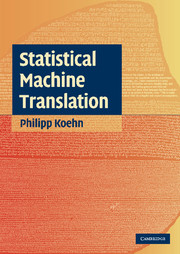5 - Phrase-Based Models
from II - Core Methods
Published online by Cambridge University Press: 05 June 2012
Summary
The currently best performing statistical machine translation systems are based on phrase-based models: models that translate small word sequences at a time. This chapter explains the basic principles of phrase-based models and how they are trained, and takes a more detailed look at extensions to the main components: the translation model and the reordering model. The next chapter will explain the algorithms that are used to translate sentences using these models.
Standard Model
First, we lay out the standard model for phrase-based statistical machine translation. While there are many variations, these can all be seen as extensions to this model.
Motivation for Phrase-Based Models
The previous chapter introduced models for machine translation that were based on the translation of words. But words may not be the best candidates for the smallest units for translation. Sometimes one word in a foreign language translates into two English words, or vice versa. Word-based models often break down in these cases.
Consider Figure 5.1, which illustrations how phrase-based models work. The German input sentence is first segmented into so-called phrases(any multiword units). Then, each phrase is translated into an English phrase. Finally, phrases may be reordered. In Figure 5.1, the six German words and eight English words are mapped as five phrase pairs.
Information
- Type
- Chapter
- Information
- Statistical Machine Translation , pp. 127 - 154Publisher: Cambridge University PressPrint publication year: 2009
Accessibility standard: Unknown
Why this information is here
This section outlines the accessibility features of this content - including support for screen readers, full keyboard navigation and high-contrast display options. This may not be relevant for you.Accessibility Information
- 6
- Cited by
